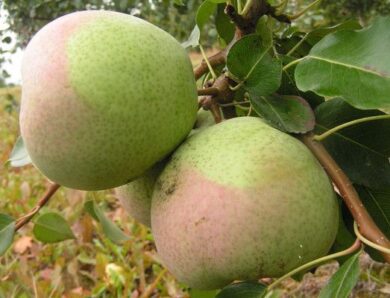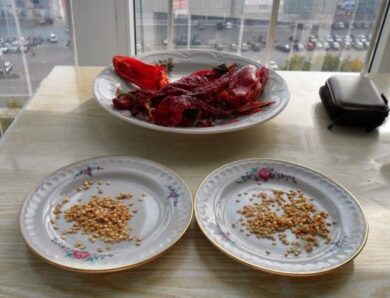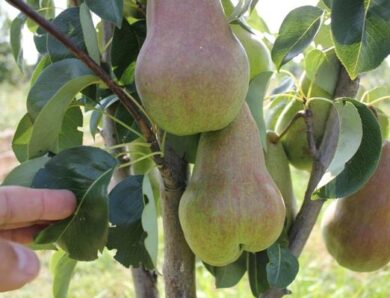Diseases of cucumbers: review of the most common
Cucumber diseases are unpredictable and dangerous in the first place, arising at the slightest violation of the conditions of cultivation. Despite the fact that already resistant to some diseases varieties of cucumbers, most are still vulnerable to pests of all colors. As you know, it is better to know the enemy in person. Cucumber diseases and their treatment is the subject of this article.
Powdery mildew
The leader in the frequency of damage to cucumber leaves - powdery mildew. It manifests itself, as a powdery whitish plaque over the entire area of leaves and stems. If ignored, the disease spreads to the plant as a whole, leading to yellowing of cucumber shoots, and then their complete drying. The disease is caused by fungal microflora. Most often it leads to the death of the plant.
The "harvest" season of powdery mildew occurs in the dark, cool periods, at an air temperature not higher 18-19 ° C. She is surviving the winter well, therefore it can be stored on plants not removed from the garden, to move to the neighboring bushes in the new season.
Shrubs with excess nitrogen are most prone to powdery mildew, especially if they are watered irregularly. So, arranging "drying" of the soil, the day before feeding cucumbers a large dose of fertilizer, containing nitrogen, you put the bushes at risk of powdery mildew.
Disease prevention is a game of anticipation. Try not to plant cucumbers in the same place for two years in a row, spend them in the garden so, that on the previous site of landing they returned not less, than through 3-4 years. At the end of the fruiting period, completely remove the plants from the beds. Greenhouse treatment, plots in the open ground should occur immediately after harvesting cucumbers from the beds. air temperature (especially in greenhouses) should not fall below, than plus 24-26 ° C, so as not to create a favorable environment for fungal growth. Use warm water for watering, so that there was no sharp drop in soil temperature. Regular treatment of plantings with fungicides will not leave any chance of powdery mildew.
At the first symptoms of the disease, plants should be treated with antifungal drugs, example, Topsin-M or Topaz. Dissolve in 10 l of warm water 2-3 milliliter of the selected drug, start spraying the bushes. The procedure is best performed in windless, dry days.
To overcome the dominance of powdery mildew, use well-proven copper chloride. On 10 l warm water take 40 grams of copper chloride, and then start spraying.
During periods of flowering or fruiting, the use of chemicals is highly undesirable, so you can use:
- mullein tincture (1 kilogram of raw material for 3 days soak in 3 And water, then dilute more 3 l of water before use);
- whey (1 l of sour milk mixed with 1 And water, filtered);
- soda-soap solution (50 grams of soda mix with 50 grams of household. honey, dilute in 10 And water).
False powdery mildew
The disease manifests itself, as bright, slightly yellowish or white spots on the entire surface of the leaves. After some time, the affected areas begin to turn brown, then dry. The main danger of powdery mildew - it can appear at any stage of culture.
False powdery mildew is a fungal disease, developing in conditions of high humidity. Contributes to this as excessive soil moisture, and excessive thickening of plantings.
As a prevention of the appearance of false powdery mildew you need to regularly thin the density of cucumber shoots, tie and pinch them. Certainly, cucumbers should not be planted in one place for two years in a row. At the end of the season you need to completely remove the plants from the ground. Forget about watering with cold water. Excessive watering, in principle, is unacceptable. Also, regularly spray with fungicides or whey.
If the disease is detected, watering should be stopped, avoid fertilizing, to carry out pinching. As a first aid, treat the plantings with a solution of polycarbicine, solution of Bordeaux or copper chloride. You can use drugs "Ordan", Rydomil. Stable temperature in the greenhouse is required during treatment, close 25 ° C. When growing cucumbers in the open ground, hide them under the film.
brown spot
Diseases of cucumbers are usually manifested primarily on the leaves and stems of plants, brown spotting is no exception. The disease is characterized by the appearance of green with a brown tinge ulcers on plant stems. After a while the spots increase, while the letter itself darkens.
The problem is, that brown spot affects the plant completely. The disease is actively developing and spreading in cool weather, when the humidity rises, example, during heavy rains. It is often caused by sudden changes in air temperature, example, in case of unexpected night frosts. Rain contributes to the spread, wind, contaminated soil. Winters brown spot on plant debris and soil. Fungal spores are hardy.
To prevent cladosporiosis, cucumbers are transplanted to a new location every year, Be sure to disinfect the soil before planting. Ventilate the greenhouse, and maintain a stable temperature, in the open area cover the beds with plastic wrap, if there are frosts. At the end of fruiting, after harvest, be sure to remove the aboveground and underground part of the plants.
Finding brown spots on their plants, stop watering at least on 5 days. Try to stabilize the air temperature at the level 20-24 ° C, to create unfavorable conditions for the life of fungal spores. Plants should be treated with fungicides, Bordeaux liquid, copper chloride or the drug "oxime". Be sure to remove the bushes from the beds, who are actively affected by the disease, so that they do not spread it to neighbors.
White rot
Fungal diseases are a real scourge of cucumbers. One of them, white rot, tends to appear over the entire area of plants. Symptoms of it: whitish spots appear, after a while they darken to black, the bush is covered with a thick whitish plaque, becomes slippery, soft, subsequently rots.
The root of the problem is the activity of the sclerotia fungus, which survives the winter well and develops very quickly and, sadly, spreads in moist soil, at high humidity.
As in the case of previous illnesses, you can avoid the onslaught of white rot, regularly thinning the density of plantings, annually transplanting cucumbers to a new place. It is very important not to overwet the ground, ventilate the greenhouse every day, thinning leaves, create access to fresh air in the beds. Be sure to remove the plants from the soil after harvest, treat it with antiseptics and fungicides.
The disease must be treated by removing the infected parts, treating slices with ash or lime. In case of a large defeat will have to completely remove the bush from the bed, because without it you will not be able to cure the landing. Treat the bushes with any fungicide, then carry out therapeutic top dressing with mineral fertilizers (v 10 l of water dilute 10 grams of urea, 1 grams of zinc and 1 grams of copper sulfate).
gray rot
Gray rot is characterized by brown spots, dusted with gray plaque. It affects the whole plant, therefore it is necessary to act decisively and without delay. As with all fungal diseases, gray rot actively multiplies in too moist soil, as well as lowering the air temperature.
Fungal diseases of cucumbers and their treatment are largely identical. Affected shrubs should be treated with a fungicide with active substances against gray rot, "Rovral" and "Bayleton" will be suitable. Reduce or stop watering plants completely during treatment with antifungal drugs. It is necessary to remove all infected bushes.
root rot
Root rot is visible to the naked eye on the rot of leaves. The plant dries up, if you look at the roots, then they are red and crumble. Unlike previous diseases, root rot actively develops at high temperatures, insufficient soil moisture or excessive watering with low temperature water.
The fight against root rot is under the motto "get thickening of plantings". Harmful activity of the disease can be prevented: try not to water the bushes with very cold water, especially in hot periods, and treat plants with fungicides each 2-3 weeks.
In the case of root rot, you need to stimulate the development of the root system of cucumbers. Add fresh fertile soil to the beds, trim the lower leaves, and dig the stem in fresh soil. For the next few 10 days irrigate the soil around the plants with warm water. Use a yeast solution. Dried bushes will have to be removed from the soil, treat with antiseptics (example, iodine solution) and fungicides.
verdigris
Brown mosaic on cucumbers, through which the plant begins to wither, and the fruits are covered with wet ulcers - a sign of defeat of the culture of copper. Most often, copperhead progresses and develops on infected seeds, not calcined or treated before planting. Also, the fungus quietly winters in the upper soil layers. Copper is activated when the temperature changes or abundant watering with cold water.
Preventive pest control is carried out at several levels. First of all, transplant cucumbers every year or take care of soil renewal. Having harvested completely, remove the plant from the ground. Do not use seeds, taken from infected plants, be sure to process them before planting. Pests take advantage of your inattention, to deal with them, you must always be alert.
Take for treatment 1% Bordeaux solution, how to spray the bushes every week. Infected segments of the bush should also be removed, close the slices with copper sulfate or lime. Copper sulphate can be used to treat the soil after harvest, to kill the fungus.
Video "Methods of combating diseases of cucumbers"
This video will suggest some simple and effective tricks, will help you effectively cope with various diseases of cucumbers in your garden.




